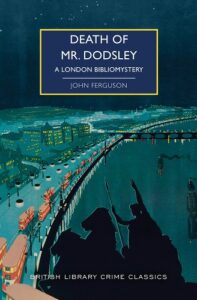Death of Mr. Dodsley, first published in 1937, is a “biblio-mystery” from a Scot who combined ministry in the Episcopalian church with a varied and successful literary career. John Ferguson was in his heyday described as “one of the most delightful stylists in the genre,” yet he has largely been forgotten during the seventy years since his death.
This story centres round the murder of a bookseller in London’s Charing Cross Road, long regarded as a home-from-home for bibliophiles. Richard Dodsley’s corpse is found lying on a carpet in his shop by Constable Roberts in the early hours of the morning. For clues, the Scotland Yard detectives Inspector Mallet and Sergeant Crabb do not have much to work on, although they find three cigarette ends and a woman’s broken hair-slide at the scene of the crime and notice that several books are out of position on the shelves. Further, they discover a note indicating that, a couple of months before his death, Dodsley consulted a private detective, Francis MacNab.
During “the Golden Age of Murder” between the two world wars, both Father Ronald Knox and Canon Victor Whitechurch achieved a considerable reputation in the field of literary detection. John Alexander Ferguson (1871– 1952) is rather less well-known, perhaps partly because his series detective was, for all his amiability, a relatively low-key character who is not quite as memorable as many of his peers in vintage crime fiction. Not much has been written about Ferguson over the years, so I shall take this opportunity to sketch an outline of his life and work.
Ferguson was born in Callander in Perthshire and worked as a clerk on the local railway before becoming ordained as an Episcopalian minister. His ministry took him to places such as Dundee, Guernsey, and Glasgow, and it was not until he was in his forties that he began to carve a literary reputation. Shortly before the First World War, he achieved success as a playwright, thanks to his widely admired one-act play Campbell of Kilmohr, set in the aftermath of the Jacobite rebellion of 1745. Professor Alan Riach has said that the play concerns “the predicament of a Highlander confronted with the sly duplicity of a Lowlander’s military interests. It would have some resonance after the First World War in its treatment of loyalty and betrayal. In the 21st century, in the context of the international popularity of the TV series Outlander, it warrants reappraisal.”
In 1915 Ferguson became school chaplain at Eversley, an exclusive girls’ school then based at Sandgate, a coastal village near Folkestone in Kent. The following year, he wrote a paper for the Folkestone War Refugees’ Committee on how the town could best help Belgian refugees. 1918 saw the publication of his first thriller, Stealthy Terror, and on the Kent Maps Online website, Professor Carolyn Oulton points out that: “In a memorable scene in Folkestone, the narrator watches human ‘butterflies’ on the Leas, as they gather round a military band. The bandstand had been erected in 1893, when Folkestone ranked as one of the more fashionable Victorian resorts. But as Ferguson’s readers would have been well aware, the Leas promenade gives on to what would later be designated The Road of Remembrance, along which thousands of soldiers had passed on their way to the trenches.” The novel, which recounts how John Abercrombie, a medical student who is staying in Berlin shortly before the war, is drawn into taking charge of a secret document, enjoyed success on initial publication and also, decades later, as a green Penguin paperback.
Two more thrillers, The Dark Geraldine (1921) and The Secret Road (1925), followed; the respective settings were Perthshire and India. The Man in the Dark (1928) was subtitled An Ealing Mystery; although the story is as much a thriller as a conventional whodunit, Francis MacNab, Ferguson’s Scottish sleuth, plays a part. In 1976, the book was dramatised for radio broadcast on Radio 4. Murder on the Marsh (1930) is a detective novel principally narrated by the journalist Godfrey Chance, who acts in effect as MacNab’s “Watson”. MacNab is asked by Ann Cardew to solve the puzzle of her father’s strange behaviour. Shortly after this, James Cardew dies. There is no obvious sign of foul play, but MacNab wonders if an ingenious crime has been committed.
Ferguson then changed publishers, and Death Comes to Perigord (1931), perhaps his best-known detective novel, appeared under the legendary Collins Crime Club imprint. The greatest strength of this mystery is the unusual setting, on the island of Guernsey. It was followed by two more Scottish novels, Night in Glengyle (1933), an adventure story, and The Grouse Moor Mystery (1934), which has an “impossible crime” ingredient, before Ferguson turned to writing about London in this book. By the time Death of Mr. Dodsley was published, Eversley School had relocated to Lymington, on the Hampshire coast. Although Ferguson remained school chaplain for a while, the dedication to the novel indicates that at the time of publication he was living at Cerne Abbas in Dorset. Thereafter he moved to Culross before retiring in 1946. His final mystery, Terror on the Island (1942), again benefited from his knowledge of Guernsey. His non-criminous work includes Dalgarney Goes North (1938), a novel in which he returned to Scottish history and chronicling the aftermath of the ’45.
Dorothy L. Sayers was among Ferguson’s admirers. She heaped praise on Night in Glengyle, saying in the Sunday Times that “your reviewer quite forgot to be cunning and was properly taken in by the surprise-packet at the end,” although, like her successor as crime critic for the Sunday Times Milward Kennedy, she was less convinced by Ferguson’s adherence to the tenets of “fair play” detection. In the first major full-length study of the genre, Masters of Mystery (1931), H. D. Thomson described Ferguson as “one of the most delightful stylists in the genre.” Ferguson’s determination to vary the backgrounds of his books as well as the type of stories he wrote strikes me as interesting and rather impressive, and it is good to see a novel of his back in print in Britain after a very long absence from the shelves.
_______________________














